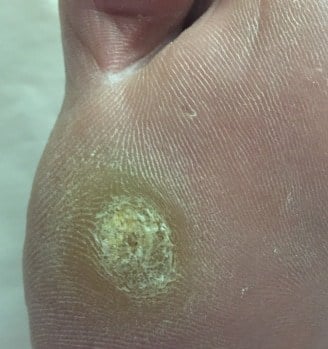
Causes of Warts on the Foot

Plantar warts causes and symptoms
Plantar Warts: Cause
Warts are caused by a virus. It often enters the skin through a break caused by athletes foot, running, blisters, cracks and sweaty feet. Hotel rooms, gym classes, wrestling, pools are all commonly infected areas- virtually anywhere a barefoot person with warts would walk!. Different strains of warts appear anywhere in the body you have skin. Warts on the bottom of the foot “plantar warts”. Plantar just means the bottom of the foot. Human Papilloma Virus (HPV) is the virus that causes warts.https://bvfootclinic.com/foot-care-and-treatment-gallery/
Protective sandals can be helpful in prevention as the HPV (Wart Virus) is spread by direct contact and likes a moist environment to live. Pregnant women, children and teenagers are more susceptible to warts than adults.
picture of plantars wart on the foot
Identifying Warts
Signs and symptoms of plantar warts include:
- a little, rough growth on the bottom of your foot, typically at the base of your toes, on the ball of your foot, or on the heel
- The growth may be paler on brown and black skin than on unaffected skin.
a callus is a swollen patch of hard skin that covers a wart that has turned inward. - Small occluded blood vessels in the form of black pinpoints, often known as wart seeds,
- The sole of the foot has a collection of growths (mosaic warts)
a growth that obstructs the skin’s natural ridges and lines on your foot - Walking or standing can cause pain or tenderness.
What causes plantar warts on bottom of feet?
How are plantar warts caused? Plantar warts are caused by a virus.
How do you get rid of plantar warts?
- Remove warts by cutting them out.
- Laser destruction of plantar warts is the most pain free way to kill them.
- Special strong acid found only in a Podiatrist office can help get rid of warts.
Tips for Prevention
- Keep your feet clean and dry.
- Do not go barefoot in hotel rooms, gyms, locker rooms, or pools,
- Wear slippers or sandals in public areas.
- Don’t touch or pick at your warts.
- Check children’s feet regularly.
Self Treatment
Malignant melanoma or other dangerous conditions can look like warts to the untrained eye, so don’t treat these at home! Many OTC wart medicines can damage surrounding skin, thus allowing the wart to more easily spread to other areas of your foot. calluses mistakenly treated as warts can easily become infected by acids causing cracks in your skin, allowing bacteria in.
Office Treatment
There are many different ways to treat warts in the office. Our Podiatrist will evaluate them and choose a treatment with you based on such things as:
- How many warts are there?
- How big are the warts?
- How long have the warts been there?
- What sports do you play?
- What does your job entail?
- How good is your immune system (diabetic, autoimmune disease, anti- rejection medications? blood supply, and age to name a few factors your podiatrist will consider.
All of this goes on instantly in your doctors mind with out you even realizing it!
Is It Possible For Plantar Fasciitis To Affect Both Feet At The Same Time?
Yes, in some cases plantar fasciitis might be able to affect both feet at the same time, although the problem being in a single foot is much more common. But if you have developed this problem in both feet at the same time, then there might be some of the causes:
1. Improper Footwear: Shoes with a proper support, and arch are extremely unreliable and can easily lead you to problems like plantar fasciitis.
2. Obesity: Obesity is known for many problems, and it can affected you physically as well, which is why it leads to plantar fasciitis since it puts excess stress on both feet.
3. High-Impact Activities: Running or standing for too long also puts a great amount of pressure on your legs, especially if you are doing these activities on hard surfaces, which highly increases the risk if injuries.
4. Biomedical Issues: Conditions like flat feet, high arches, or abnormal gait patterns can lead to plantar fasciitis more often than normal people.
Can Plantar Fasciitis Turn Into A Chronic Condition?
Yes, plantar fasciitis can easily lead to a chronic conditions, especially if you leave it untreated or manage it improperly. Chronic plantar fasciitis can happen when inflammation or pain in plantar fasciitis lasts for more than several months or even years.
Factors That Lead To Chronic Plantar Fasciitis:
1. Ignoring Early Symptoms: The first and most recognizable symptom of Plants fasciitis is the sharp pain in feet in the morning, however if you choose to ignore it and continue activities with that strain then plantar fasciitis can progress further.
2. Improper Footwear: As mentioned earlier, improper footwear with terrible support and no arch leads aren’t protective enough for your feet.
3. Not Treating The Condition: Plantar fasciitis can’t go away on its own, you need to get it’s treatment and allow your feet to rest.
Treatment Options
- Trim excess dead wart tissue prior to treatment to be more effective.
- Salicylic acid
- Cantharidic acid (beetle juice!)
- Novocaine and excision
- Laser destruction of plantar warts.

